It’s time to let go of the canvas

It’s quite a trip to read the Wikipedia page on ‘business model‘ where the business model canvas designed by Pigneur and Osterwalder is barely a footnote. In real life, there is probably just a handful of startups or multinationals that haven’t use this tool at some point, as a key element of creativity and to some extent, innovation or strategy.
For those of you that were frozen in carbonite since 2008, this is what the canvas looks like:
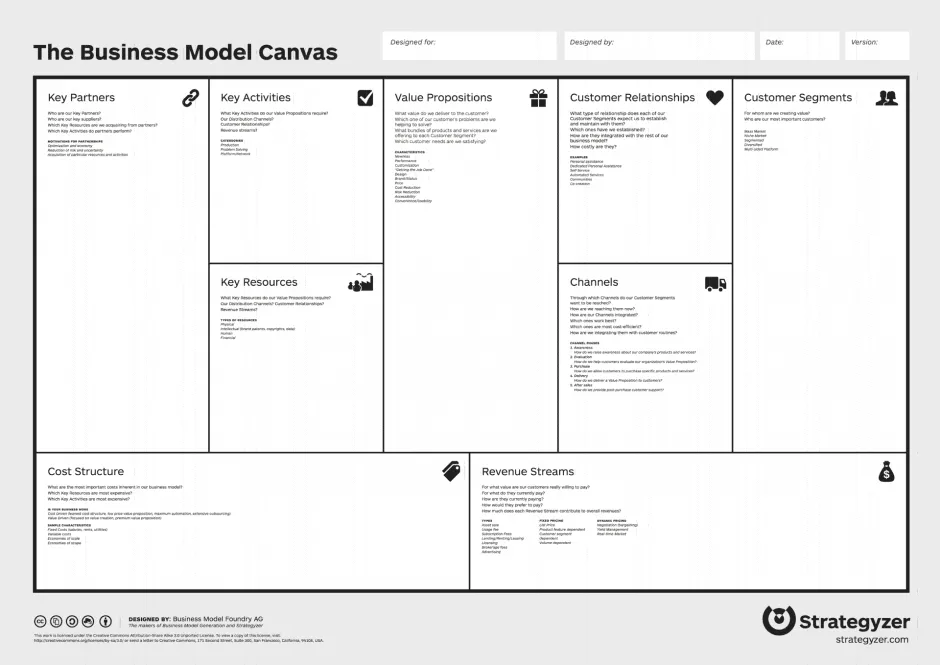
Trading Complexity for Focus?
It is a very well thought redesign of numerous tools that along the years helped to frame, using only a few elements, what is the core logic of a specific business. The central idea shared for decades by business strategists was that if you could explain your business on a napkin, then you’d have to be super-focused on the key elements driving your operation.
pic.twitter.com/NpmUnZgVfHJune 7, 2014
By unmasking these elements and presenting them clearly, it would be that much easier to reorganize them, build new possibilities, and plan future scenarios.
As a business student, if you’re interested in exploring the long history of framing complex businesses in a simple model, you could probably go back to 1962’s “Strategy and Structure” from Alfred D. Chandler, Jr. I’m not saying that this is an old field of work in term of business literature, it’s ancient!
So glad to know that we already had dozens of different ways to simply explain business models, why was the canvas so important then?
As professionals, we tend to forget how business books are just bloody unreadable. They are boring, written and presented as soviet textbooks on nuclear engineering, and usually, explain in hundreds of pages what could have been presented with a well-thought-through picture. The seminal contribution of Pigneur and Osterwalder was, in my opinion, to reverse that, which is even more remarkable knowing that Osterwalder was essentially a young academic when he launched his project in 2008.
Within a few years, the Business Model Generation book caught as a wildfire. First with startups and the first wave of a young educated generation hit hard by the crisis, that smartly surfed on the money granted to startups right and left in Europe and the US. Then, a few years after, by a horde of creativity / innovation consultants, that found a fantastic pedagogic tool to help get senior executive and engineers digest new perspectives for their failing companies.
There was (and still is) a dark side to this wave of positive evangelization on business model design. Namely, the canvas or any other way to frame simply a business model can only be the first step in a consolidated, global approach to business strategy. Throwing post-its on the wall neither helped an executive committee work out his lack of business vision. And when there is no solid follow-up on ideation, the next morning it’s back to business as usual.
I’m pretty sure that most of you understand exactly what I’m speaking about.
That’s an obvious catch-22: reach out and make accessible complex tools to a large crowd and they will use them in a limited way (thinking they did the job); don’t make them accessible and let experts play gurus (with more or less success).
About Cobbler’s Children Not Going Barefoot
As far as I’m concerned, I pretty much never used the canvas past the novelty effect, and the required obligation to test in real life such a successful template. The only reason for my lack of enthusiasm with the canvas is that I’m in a very narrow and specialized business.
I deal with startups and corporate innovators, which translates in dealing with significant risks.
Now, I know, I know… When everyone is a startuper or an intrapreneur, and when everyone spends their weekends eating pizzas in hackathons, you may be under the impression that this is now mainstream innovation.
I fondly remember in the 90s how everyone was so deeply committed to quality management, to the point where grocery stores down the street were probably feeling they should get ISO 9001… Let’s say that innovation is just like that right now. If you feel mean-spirited, I’d recommend that you ask the next innovation VP you meet in a party, how many startups have matured from their incubation program in the last 3-5 years. Or worse: what % of the bottom-line has directly been impacted by their program (hint: if he gives a number he’s lying).
If we go back to the canvas, my problem with it from the start is that in a specialized approach to businesses such as mine, it’s just too vague. It is his force elsewhere, for me, it’s impossible to use it.
When dealing with startups, you need to play immediately with the complexity of unborn projects that need to find a very focused vision and, at the same time, connect incompatible logics together:
- Ramp up the business on a shoestring;
- Go to the market, but don’t finish your product;
- Make money, but decide on pricing later;
- Break the status quo, but get everyone on board;
- Etc.
I tried to share a few specifics a few days ago:
So, practically if you want to push forward and actually deliver results with startup-like projects – I encompass non-incremental corporate innovation projects here – you need more acute tools. And again many of them exist, such as the “lean canvas” that speaks about ‘Problem’, ‘Unique Value Proposition’, and ‘Solution’. I’d like to share here how we work at Merkapt.
We call it the Focus Canvas.
Don’t take it as a copy-paste solution. This is a very specific tool. A tool. Specific. Not a methodology that you can magically apply to an SME that has marketing problems, or to a restaurant that needs to fix hygiene problems. With startups for me it boils down to help them connect as quickly as possible the contradictions involved in 1) solving a clear market problem + 2) building a clear added value doing so + 3) delivering a product as quickly as possible (because in the end this is about business, not winning innovation contests with your local chamber of commerce).
So we start with exactly these key points:
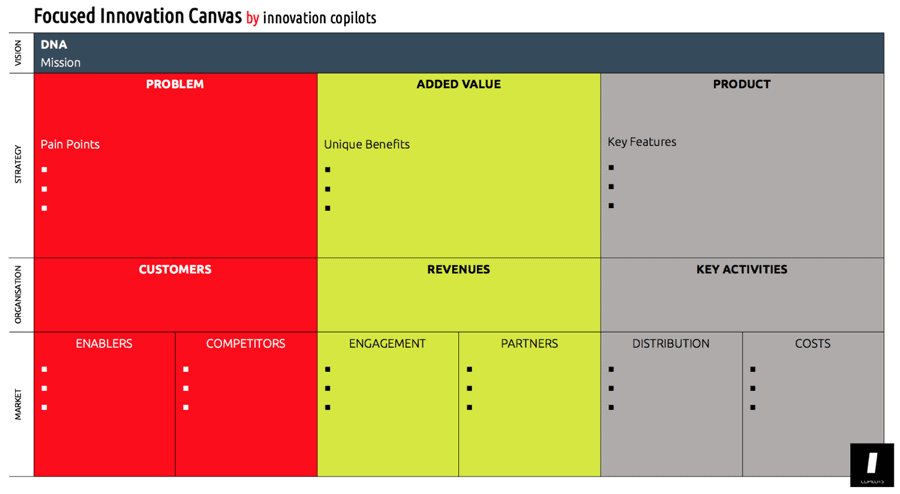
If you’re old and grumpy, you can say ‘Solution’ instead of ‘Product’, and differentiate services from that, but this is quite a joke and no-one knows the difference anyway.
And as you can see, above it all I put pressure on the focus discipline they have: knowing that they cannot excel at everything with their inbuilt lack of resources, where is the founding team choosing to excel, maintaining only “good enough” attention on the rest of the project
Starting with the ‘Focus’ I channel it through only 3 options. The founding team is solution-, operation-; or future-driven. Each kind of focus has its own strengths and merits but is unbalanced. This is not that detrimental if you understand where you get your edge, and where you will suffer in the long run.
What is vital, is that it helps build the project dynamics in an unequivocal way.
Now, say that the team is driven by uncanny acuity at “feeling” the market, they surf the zeitgeist and have a telepathic understanding of the subtlest desires of their potential customers. With such a market-driven people, it will be necessary to develop the business through what is the most intuitive to them, the problem side:
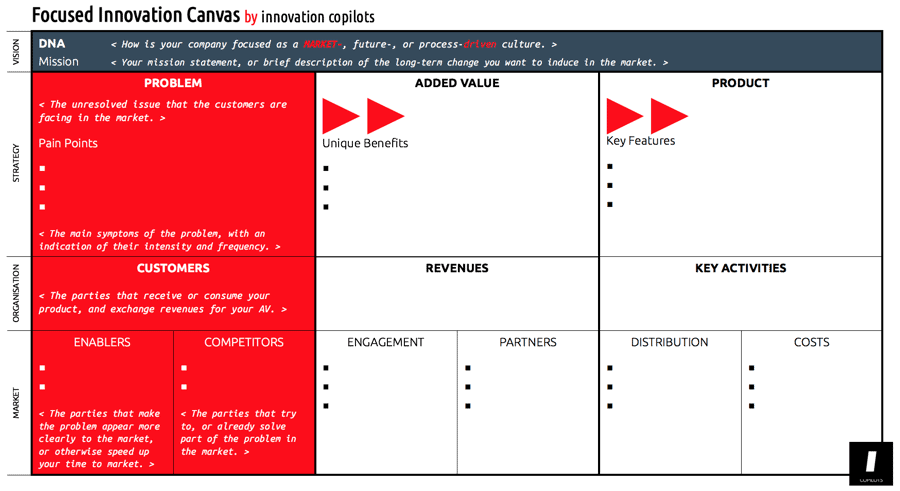
On te contrary, a team that is more Apple-like, believing that asking what the customer wants is a waste of time, will get bogged down starting with the problem side. Although all books on startups and innovation will tell otherwise, it’s mandatory that you let go of the pain points of the market for now and help them solidify their vision of the future before anything else. Doing so, you’ll start by formulating the transformative vision they have: the added value they want to deliver to the final market.
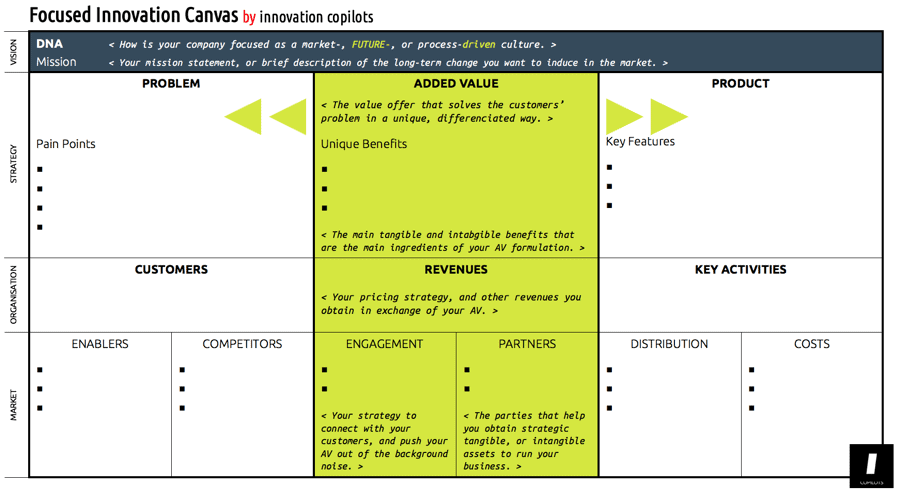
And as you already suspect, if the team is just a bunch a Redbull-drinking engineers making constant fun of a peer that doesn’t manage to get pi down to the hundredth decimals, I’ll let you exhaust yourself starting with them elsewhere than on the central product part. Although the product is only a feature of the business model, appearing only to channel the added value to the market, it will take a bit of time to get there with them. They are process-driven, play accordingly:
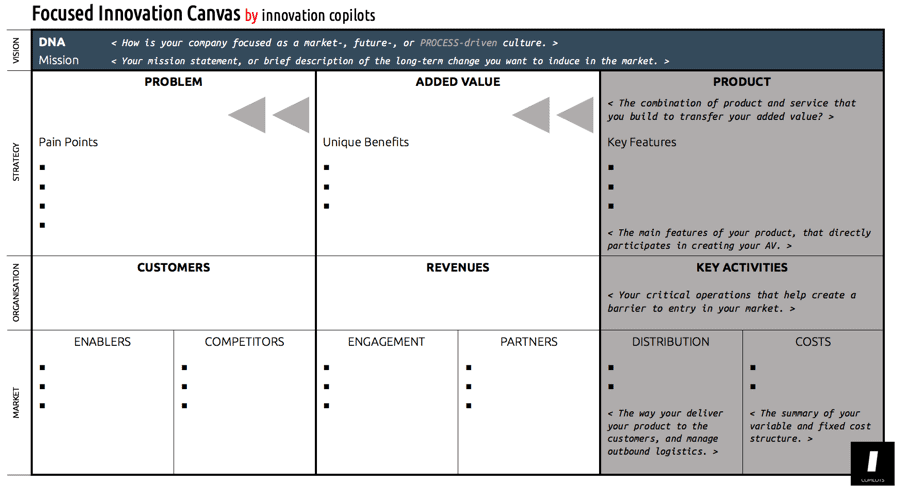
And at the end of the process, the map must be connected no matter what. The key benefits framing the added value must be delivered through specific features built-in the product, to solve the essentials pain points constituting the problem of the market. Hopefully, you do understand netter why we call this the Focused Innovation Canvas:
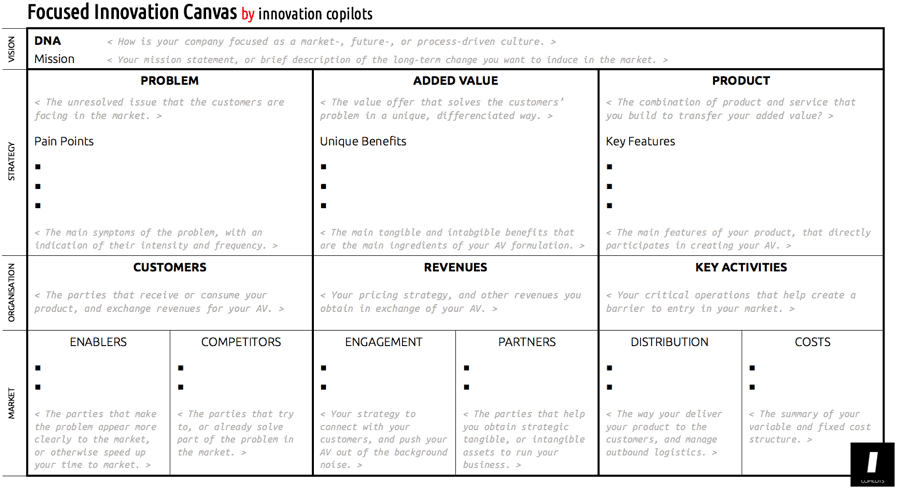
Or as a blank canvas:
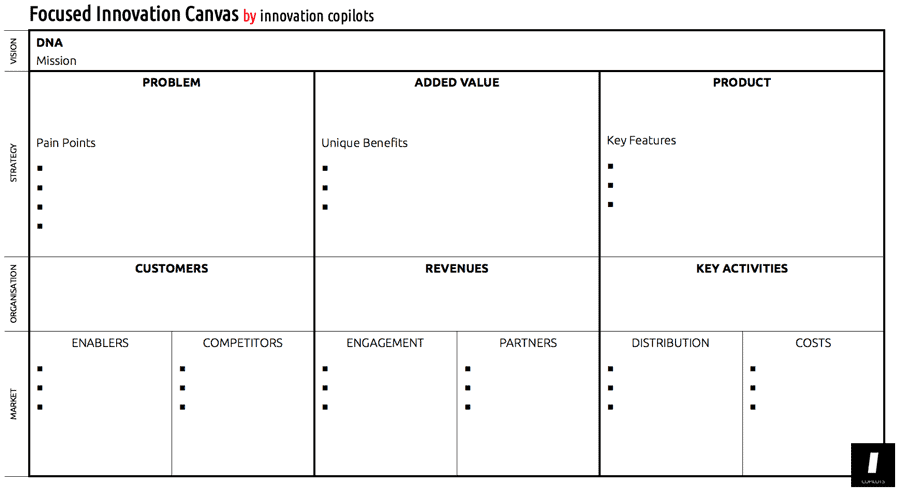
This map is a specific map.
The Focused Innovation Canvas is a pragmatic map for disrupting competitors that try to maintain a status quo or position revenues.
It’s a tool serving a specific kind of logic. Whatever is your trade or your business right now, you may want to use a business model as a sound, efficient way, to think about the future of your organization. It’s always a very good idea. But whatever your practice was these last few years, I believe that once you got rapidly educated on the business model logic with the canvas or any other generic tool, you’d start to let go of the baby wheels and start developing your own logic, your own tools.
Whatever you’re doing, it’s probably time to let go of the canvas…

Want to get your innovation muscles back in shape? Contact us for a keynote or a training.




